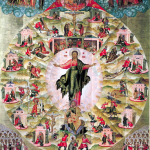In response to Matt Talbot’s recent powerful post, “Sins That Cry Out To God,” our contributor Mickey replied, “When I read about things like this, I find it very difficult to put what I feel into words.”
I agree. Matt’s post, an account of systemic abuse in Catholic schools in Ireland which could accurately be described as a form of religious terrorism, left me speechless for a number of reasons. But one feeling I had in response is the same feeling I have whenever I hear such stories: it is the overwhelming feeling that we Catholics must stop this nonsense of making the ecclesiological claim that the Church is holy, not sinful. You know what I mean: the absurd distinction between saying that the Church’s members are sinful and do sin, but that the Church could never be sinful itself because it is the “spotless Bride.”
At the Second Vatican Council, we tried to shake this idealistic (and ideological) understanding of the Church’s relationship to historical sinfulness. We didn’t quite get there, because as we know, there were ecclesiological disagreements among the Council Fathers which are still being played out today. The best we could do at the time was to imply that the Church is corporately sinful, specifically through the Council documents’ use of the image of the Church as “pilgrim,” a Church that sojourns through history, rather than simply a heavenly reality which floats above history. As a pilgrim Church “on the way” to the Kingdom, the Church must, the documents insist, undergo constant renewal. As Rahner has reminded us, if the Church as a communal reality must undergo “renewal,” the Church must then, collectively, be sinful. As Rahner wrote, “Not only every individual in the Church must truthfully and humbly confess himself [sic] a sinner, but also the Church, for she is the community of these sinners.”
As many of us are aware, we are still struggling with divergent ecclesiological visions. Among some sectors of the Church, there is a desire to deemphasize the “pilgrim” quality of the Church, to pay mere lip service to the Church’s historicity and to return to the idealized language that Vatican II tried, to some degree, to correct. And this backward ecclesiological motion is not limited to Roman Catholicism. Even in the World Council of Churches’ Faith and Order document The Nature and Mission of the Church an accommodation is made to this antiquated Roman Catholic perspective when it says:
For some, it is impossible to say “the Church sins” because they see the Church as a gift of God, sharing in God’s holiness. The Church is the spotless bride of Christ…. As such, the Church cannot sin. The gift is lived out in fragile human beings who are liable to sin, but the sins of the members of the Church are not the sins of the Church…. According to this perspective one can, and must, speak only of the sin of the members of the Church and of groups within the Church…”(The Nature and Mission of the Church: A Stage on the Way to a Common Statement, Faith and Order Paper no. 198, WCC, 2005).
Against this idealized ecclesiological revival, we must say, along with Rahner, that there is no Church apart from its members, members who are at once individuals and a collective Body. And as stories like the ones Matt relates show us — viscerally show us — we are a Body that is obviously struggling with the baggage of historical, systemic, deeply evil sinfulness. We must say, in humility, the Church sins.
The German theologian Fr. Johann Baptist Metz has said that we can no longer do theology “with our backs to Auschwitz.” The deep evil of the Holocaust, he says, must affect how we do theology and how we talk about — or don’t talk about — the Church. In his new book, Catholic theologian Tom Beaudoin says that today we can add the Church’s abuse of children to that list: we can no longer do theology or describe the Church with our backs to those the Church has abused. I think at the very least this means we can no longer say — must no longer say — the Church is “not sinful.”
















